Congenital amegakaryocytic thrombocytopenia (CAMT) presenting as severe pancytopenia in the first month of life
Abstract
Congenital amegakaryocytic thrombocytopenia (CAMT) is characterised by neonatal thrombocytopenia, with reduced or absent bone marrow megakaryocytes, leading eventually to pancytopenia. The mean age for progression to bone marrow failure is four years, with the earliest reported being six months. We describe a CAMT patient with compound heterozygous mutations of the causative MPL gene (one being a previously unreported splice site mutation in intron 11) who developed pancytopenia within the first month of life. This report emphasises the importance of considering CAMT in the differential diagnosis of congenital aplastic anaemia or idiopathic aplastic anaemia in babies. Pediatr Blood Cancer 2013;60:E94–E96. © 2013 Wiley Periodicals, Inc.




